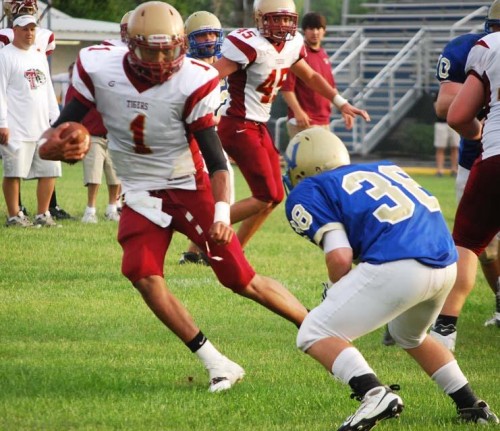Tuesday, July 13
July 13, 2010Ellis Warren Jr.
July 15, 2010There is a roughly two-and-a-half-month gap from the date spring football ends to when fall practice begins.
So with close to 80 days at their disposal, several coaches in the Tri-parish area have taken up 7-on-7 football in the summer months to keep their players sharp with the season right around the corner.
“It’s just fun,” said South Lafourche head coach Terry Farmer. “It’s like basketball on grass – that’s what we call it. It’s fun. It gives the kids a chance to work on their skills at a fast-paced and competitive environment in the summer months.”
The way to define 7-on-7 football is simple – sort of. Teams don’t actually have seven players like the name suggests – they have eight. Each team has a quarterback and a center with six wide receivers. The center is not eligible to go out for a pass, causing him to be referred to as a “dead” player, thus leaving seven skill players and the 7-on-7 name.
On defense, it’s the same concept with a “dead” defender who stands over the center, but isn’t allowed to rush the passer. The remaining seven players are comprised of linebackers and defensive backs, whose job is to defend the receivers.
“All is it is basically a big passing skeleton,” said Terrebonne coach Gary Hill.
Long story short, it’s like a trip back to childhood for some good-ole fashioned, competitive, backyard football.
Teams are allowed to practice under this format once a week, and several schools also scrimmage other schools, or play in a once-a-week league.
“It gets them out of the house,” said Farmer, who implemented South Lafourche’s summer program when he took over as coach. “It lets me see them in the summer. It’s just all-around good for the kids to be active. … It gives them something to do.”
With running plays nonexistent and quarterbacks not allowed to scramble for yardage, developing quarterbacks is a major plus of the 7-on-7 game.
Working on timing from a quarterback to a receiver as well as reading zone and man-to-man coverages are all little nuisances the 15 or 16-year-old quarterback can learn from the summer sessions.
“You’re working on those fundamentals and those little techniques that can help them do better in the passing game when it comes to football,” said Hill.
For a school like Terrebonne with a big-time quarterback like senior Mike Williams returning, any small advantage earned in the summer could be the difference between a win or a loss when the fall season begins.
So for teams like South Lafourche and Thibodaux who are more run-oriented teams, they do 7-on-7 for a different reason – to be better able to keep up with the elite quarterbacks like Williams they will see in the season.
“The biggest thing for us because we don’t throw the ball as much is working on our defensive backfield,” Farmer said. “We work on our different coverage schemes – man, zone and combination coverages. We teach the kids how to defend in space. We want to see what kinds of hips the kids have, so in the fall, we know who can cover in space and who can’t.”
At Thibodaux, the focus is the same. Coach Dennis Lorio said his team uses the drills as a steppingstone for the fall – while also understanding the drills are not a fully accurate view of what will be seen in the season.
“The quarterback is out there with an unobstructed view of the field,” Lorio said. “The other thing you’ll see is the linebackers will be playing farther off the line of scrimmage here than they will in the fall, because they have no commitment to honor the run. … We do it, and we think it has some value, but we don’t over-emphasize it.”
Hill agreed and said the competition level the players are exposed to is great, but any “winning” or “losing” in summer is to be taken with a grain of salt.
“When 7-on-7 ends, it’s still right back to 0-0 in the standings for everyone before the fall season begins,” Hill said. “It’s just about working during the summer to give a little advantage to your quarterbacks, your receivers and your skill guys.”
The insurgence of this style of summer practice comes largely from Texas, where 7-on-7 isn’t just an offseason practice method, but it’s also a statewide spring sport.
Over the past few seasons, the Lone Star State has produced signal callers like Matthew Stafford, Chase Daniel, Colt McCoy, Ryan Mallett and Matt Flynn.
Farmer said the 7-on-7’s popularity will likely never be the same here as in Texas, though.
“Almost everybody in Texas throws the ball,” Farmer said. “We just don’t throw quite as much down here.”
Hill and Lorio agreed and expressed doubt the sport would ever become a sanctioned LHSAA sport.
“Right now just wouldn’t be a good time to start anything new with the economy,” Hill said. “They are really limiting travel and stuff like that. … But we do love what it does because it keeps the kids busy, it keeps them off the streets.”
Lorio took it a step farther and said he wouldn’t be in favor of football having an organized school sport in the spring.
“I’m a total sports guy in that I believe our kids should participate in as many sports as they can participate in,” Lorio said. “I wouldn’t be in favor in having 7-on-7 in the spring, because it would take kids away from some other sports they love. … And that’s not what we’re trying to do.”
Terrebonne quarterback Mike Williams scrambles past a Vandebilt defender in a spring scrimmage. Williams is one of several local quarterbacks being aided by 7-on-7 summer football drills. CASEY GISCLAIR









